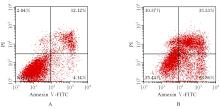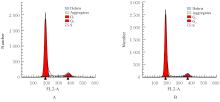Journal of Jilin University(Medicine Edition) ›› 2024, Vol. 50 ›› Issue (6): 1526-1534.doi: 10.13481/j.1671-587X.20240606
• Research in basic medicine • Previous Articles
Effect of over-expression SLC7A5 on apoptosis of ovarian granulosa cells in rats and its mechanism
Jingshun ZHANG,Yinggang ZOU,Lianwen ZHENG( )
)
- Reproductive Center,Second Hospital,Jilin University,Changchun 130041,China
-
Received:2024-01-08Online:2024-11-28Published:2024-12-10 -
Contact:Lianwen ZHENG E-mail:davezheng@sohu.com
CLC Number:
- R711.75
Cite this article
Jingshun ZHANG,Yinggang ZOU,Lianwen ZHENG. Effect of over-expression SLC7A5 on apoptosis of ovarian granulosa cells in rats and its mechanism[J].Journal of Jilin University(Medicine Edition), 2024, 50(6): 1526-1534.
share this article
| 1 | KANAI Y, SEGAWA H, et al. Expression cloning and characterization of a transporter for large neutral amino acids activated by the heavy chain of 4F2 antigen (CD98)[J]. J Biol Chem, 1998, 273(37): 23629-23632. |
| 2 | SUN Y M, WEN J J, XU T, et al. Reduction of peritoneal cavity B1a cells in adult SLC7A5 knockdown mice via dysregulating the mTOR pathway[J]. Int Immunopharmacol, 2023, 117: 109939. |
| 3 | PRASAD P D, WANG H, HUANG W, et al. Human LAT1, a subunit of system L amino acid transporter: molecular cloning and transport function[J]. Biochem Biophys Res Commun, 1999, 255(2): 283-288. |
| 4 | KANAI Y. Amino acid transporter LAT1 (SLC7A5) as a molecular target for cancer diagnosis and therapeutics[J]. Pharmacol Ther, 2022, 230: 107964. |
| 5 | ZHU Q N, WANG J, SHI Y N, et al. Bioinformatics prediction and in vivo verification identify SLC7A5 as immune infiltration related biomarker in breast cancer[J]. Cancer Manag Res, 2022, 14: 2545-2559. |
| 6 | SEKINE M, KOH I, NAKAMOTO K, et al. Selective inhibition of L-type amino acid transporter 1 suppresses cell proliferation in ovarian clear cell carcinoma[J]. Anticancer Res, 2023, 43(6): 2509-2517. |
| 7 | SIDORKIEWICZ I, JÓŹWIK M, BUCZYŃSKA A, et al. Identification and subsequent validation of transcriptomic signature associated with metabolic status in endometrial cancer[J]. Sci Rep, 2023, 13(1): 13763. |
| 8 | ZHANG J S, XU Y, LI D D, et al. Review of the correlation of LAT1 with diseases: mechanism and treatment[J]. Front Chem, 2020, 8: 564809. |
| 9 | 张京顺. SLC7A5在大鼠多囊卵巢综合征模型卵巢上的表达及其功能研究[D]. 长春: 吉林大学, 2021. |
| 10 | 肖晓青, 邱思花, 谢 芳, 等. 多模态子宫输卵管超声造影评估输卵管堵塞性病变的诊断价值[J]. 中国医学物理学杂志, 2023, 40(10): 1246-1250. |
| 11 | 许 川, 舒为群, 张 亮, 等. 大鼠卵巢颗粒细胞的原代培养与鉴定[J]. 癌变·畸变·突变, 2009, 21(3): 234-237. |
| 12 | 李婉玉, 郑 喜. 血清及卵泡液AMH水平检测在辅助生殖领域中的应用研究进展[J]. 延边大学医学学报, 2023, 46(4): 347-350. |
| 13 | 付璐璐. 多囊卵巢综合征动物模型卵巢中的mRNA/lncRNA表达谱及相关功能的研究[D]. 长春: 吉林大学, 2018. |
| 14 | STRINGER J M, ALESI L R, WINSHIP A L, et al. Beyond apoptosis: evidence of other regulated cell death pathways in the ovary throughout development and life[J]. Hum Reprod Update, 2023, 29(4): 434-456. |
| 15 | CACCIOTTOLA L, CAMBONI A, CERNOGORAZ A, et al. Role of apoptosis and autophagy in ovarian follicle pool decline in children and women diagnosed with benign or malignant extra-ovarian conditions[J]. Hum Reprod, 2023, 38(1): 75-88. |
| 16 | KASHI O, MEIROW D. Overactivation or apoptosis: which mechanisms affect chemotherapy-induced ovarian reserve depletion?[J]. Int J Mol Sci, 2023, 24(22): 16291. |
| 17 | GONG Y, LUO S, FAN P, et al. Growth hormone activates PI3K/Akt signaling and inhibits ROS accumulation and apoptosis in granulosa cells of patients with polycystic ovary syndrome[J]. Reprod Biol Endocrinol, 2020, 18(1): 121. |
| 18 | JIANG X L, TAI H, XIAO X S, et al. Cangfudaotan decoction inhibits mitochondria-dependent apoptosis of granulosa cells in rats with polycystic ovarian syndrome[J]. Front Endocrinol, 2022, 13: 962154. |
| 19 | LLIBEROS C, LIEW S H, ZAREIE P, et al. Evaluation of inflammation and follicle depletion during ovarian ageing in mice[J]. Sci Rep, 2021, 11(1): 278. |
| 20 | YE H Y, SONG Y L, YE W T, et al. Serum granulosa cell-derived TNF-α promotes inflammation and apoptosis of renal tubular cells and PCOS-related kidney injury through NF-κB signaling[J]. Acta Pharmacol Sin, 2023, 44(12): 2432-2444. |
| 21 | D’ARCY M S. Cell death: a review of the major forms of apoptosis, necrosis and autophagy[J]. Cell Biol Int, 2019, 43(6): 582-592. |
| 22 | SPERANSKII A I, KOSTYUK S V, KALASHNIKOVA E A, et al. Enrichment of extracellular DNA from the cultivation medium of human peripheral blood mononuclears with genomic CpG rich fragments results in increased cell production of IL-6 and TNF-a via activation of the NF-kB signaling pathway[J]. Biomed Khim, 2016, 62(3): 331-340. |
| 23 | 贺鹏翼, 董 宁, 吴 瑶, 等. 脓毒症小鼠脾脏树突状细胞焦亡及其对炎症反应和免疫功能的影响[J]. 解放军医学杂志, 2023, 48(5): 537-544. |
| 24 | ZHAO X Q, LIN Y, JIANG B J, et al. Icaritin inhibits lung cancer-induced osteoclastogenesis by suppressing the expression of IL-6 and TNF-a and through AMPK/mTOR signaling pathway[J]. Anti Cancer Drugs, 2020, 31(10): 1004-1011. |
| 25 | JUNG H, LEAL-EKMAN J S, LU Q H, et al. Atg14 protects the intestinal epithelium from TNF-triggered villus atrophy[J]. Autophagy, 2019, 15(11): 1990-2001. |
| 26 | MAZUMDER S, PLESCA D, ALMASAN A. Caspase-3 activation is a critical determinant of genotoxic stress-induced apoptosis[J]. Methods Mol Biol, 2008, 414: 13-21. |
| 27 | 肖丽君, 甘苡榕, 刘春丽, 等. 大黄灵仙方对胆固醇结石豚鼠模型胆囊Cajal间质细胞中scf/c-kit信号通路的影响[J]. 临床肝胆病杂志, 2023, 39(2): 376-382. |
| 28 | HONNMA H, ENDO T, HENMI H, et al. Altered expression of Fas/Fas ligand/caspase 8 and membrane type 1-matrix metalloproteinase in atretic follicles within dehydroepiandrosterone-induced polycystic ovaries in rats[J]. Apoptosis, 2006, 11(9): 1525-1533. |
| 29 | LIU Y, ZHAI J J, CHEN J, et al. PGC-1α protects against oxidized low-density lipoprotein and luteinizing hormone-induced granulosa cells injury through ROS-p38 pathway[J]. Hum Cell, 2019, 32(3): 285-296. |
| [1] | Siqi LI,Guangdao CHEN,Qiyi ZENG. Improvement effect of chrysophanol on hydrogen peroxide-induced apoptosis of EA. hy926 cells and its mechanism [J]. Journal of Jilin University(Medicine Edition), 2024, 50(6): 1512-1518. |
| [2] | Yuxiao SHI,Meilan LIU,Meilin ZHU,Feng WEI. Effects of 5-Aza-CdR on autophagy and apoptosis of papillary thyroid cancer cells in subcutaneous xenograft tumor tissue of nude mice and its mechanism [J]. Journal of Jilin University(Medicine Edition), 2024, 50(5): 1330-1338. |
| [3] | Yongjing YANG,Tianyang KE,Shixin LIU,Xue WANG,Dequan XU,Tingting LIU,Ling ZHAO. Synergistic sensitization of apatinib mesylate and radiotherapy on hepatocarcinoma cells invitro [J]. Journal of Jilin University(Medicine Edition), 2024, 50(4): 1009-1015. |
| [4] | Guoxing YU,Xin ZHANG,Hengwei DU,Bingjie CUI,Na GAO,Cuilan LIU,Jing DU. Effect of urolithin C on proliferation, apoptosis and autophagy of human acute myeloid leukemia HL-60 cells and its mechanism [J]. Journal of Jilin University(Medicine Edition), 2024, 50(4): 908-916. |
| [5] | Chao LIANG,Juanjuan DAI,Ning ZHOU,Dandan WANG,Jie ZHAO,Di AN,Yan WU. Effect of oridonin on cell proliferation, migration, and apoptosis of human nasopharynx carcinoma HONE-1 cells [J]. Journal of Jilin University(Medicine Edition), 2024, 50(4): 917-924. |
| [6] | Tengfei WANG, Feng CHEN, Ling QI, Ting LEI, Meihui SONG. Inhibitory effect of D-limonene on proliferation of glioblastoma cells and its mechanism [J]. Journal of Jilin University(Medicine Edition), 2024, 50(3): 647-657. |
| [7] | Jiacai FU,Lingsha QING,Lu YANG,Meihui SONG,Xianying ZHANG,Xiaocui LIU,Fengjin LI,Ling QI. Inhibitory effect of Schisandrin B on proliferation of pancreatic cancer Pan02 cells and its mechanism [J]. Journal of Jilin University(Medicine Edition), 2024, 50(3): 638-646. |
| [8] | Lin CHEN,Limin YAN,Huaijie XING,Min CHEN,Xiaoyan LI,Chaosheng ZENG. Improvement effect of Xuebijing on brain tissue injury and Th17/Treg immune imbalance in cerebrospinal fluid in NMDA receptor encephalitis model mice [J]. Journal of Jilin University(Medicine Edition), 2024, 50(3): 697-707. |
| [9] | Linru WANG,Jing ZHANG,Dongchan ZHAO,Jinjun WANG,Wenxian HU. Effect of silencing FOXO1 gene on autophagy and apoptosis of human aortic vascular smooth muscle cells [J]. Journal of Jilin University(Medicine Edition), 2024, 50(2): 431-441. |
| [10] | Donghong CAI,Qing LI,Lingling KE,Huiya ZHONG,Qilong JIANG,Han ZHANG,Yafang SONG. Expression of mitophagy and apoptosis related genes in peripheral blood mononuclear cells of patients with myasthenia gravis and its clinical diagnosis value [J]. Journal of Jilin University(Medicine Edition), 2024, 50(2): 481-488. |
| [11] | Huijuan SONG,Zhenhua XU,Dongning HE. Effect of apolipoprotein C1 expression on proliferation and apoptosis of human liver cancer HepG2 cells and its mechanism [J]. Journal of Jilin University(Medicine Edition), 2024, 50(1): 128-135. |
| [12] | Yaxin LIU,Jian LIU,Zhen LI,Zhanhong CAO,Haonan BAI,Yu AN,Xingyu FANG,Qing YANG,Hui LI,Na LI. Inhibitory effect of royal jelly acid on proliferation of human colon cancer SW620 cells and its network pharmacological analysis [J]. Journal of Jilin University(Medicine Edition), 2024, 50(1): 150-160. |
| [13] | Yan WANG,Xiaohui LI,Yao JI,Lili CUI,Yujie CAI. Differential effects of APOE polymorphism in neurotoxicity-responsive astrocytes induced by inflammatory factor [J]. Journal of Jilin University(Medicine Edition), 2024, 50(1): 33-41. |
| [14] | Mengxue WU,Shiling CHEN,Yan LIU,Xuguang MI,Xiuying LIN,Jianhua FU,Yanqiu FANG. Effect of culture supernatant of human umbilical cord mesenchymal stem cells on survival,apoptosis and endometrium receptivity of human endometrial stromal cells after treated with mifepristone [J]. Journal of Jilin University(Medicine Edition), 2024, 50(1): 79-87. |
| [15] | Zhongxin FENG,Mei LI. Effect of soluble CD40 ligand on biological behavior of THP-1 cells through long non-coding RNA linc00239 [J]. Journal of Jilin University(Medicine Edition), 2024, 50(1): 88-96. |
|
||













